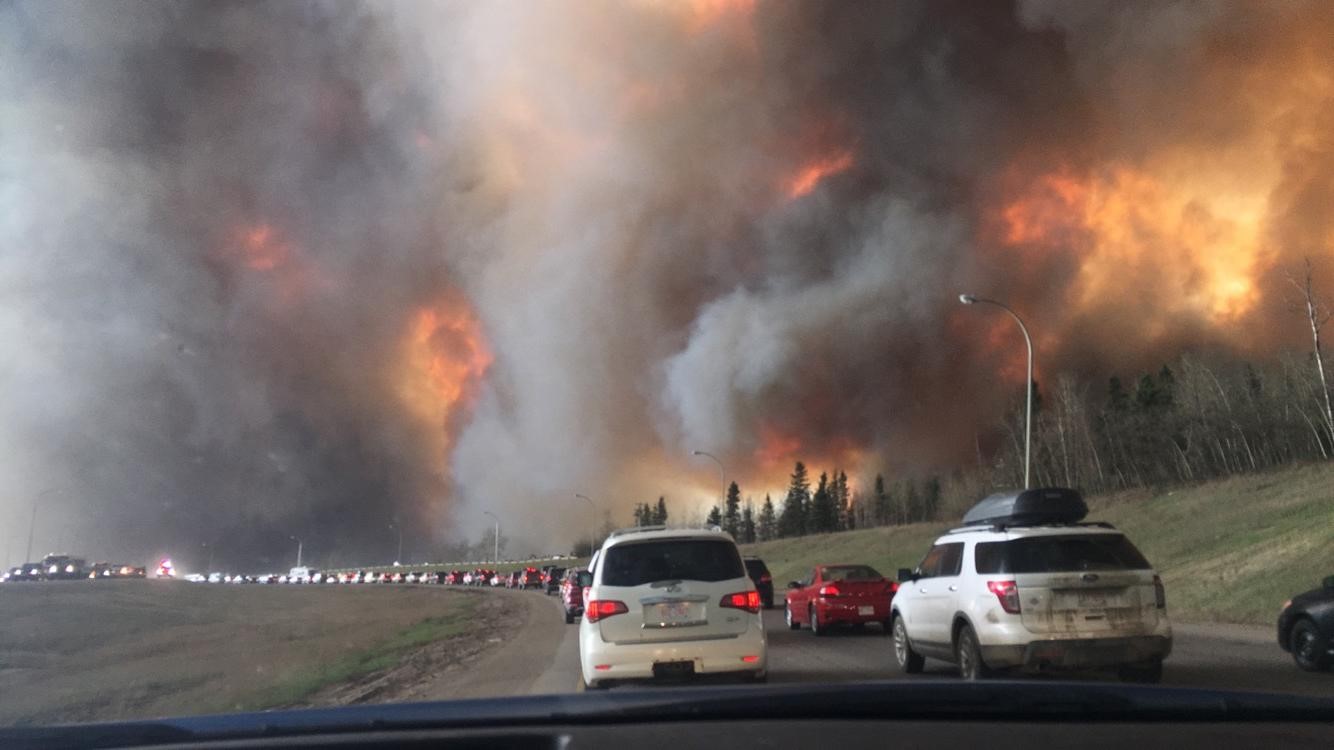 Evacuation along Highway 63, from Wikimedia Commons courtesy DarrenRD[/caption]
As the fire picked up early on Tuesday, our FirstLook team at DigitalGlobe started acquiring satellite imagery and we began tracking the fire from space. This was in the morning, at the time the fire was on the outskirts of the town and voluntary evacuations were taking place in a few neighborhoods. Things got crazy after that afternoon as winds blew in at 70km/hr, and the fire grew fast and unpredictable. A mandatory evacuation was put in place for the entire city. This is unprecedented; the fire is still burning and this is expected to be the costliest natural disaster in Canada’s recorded history. To put this in perspective, the worst disaster in Alberta’s history took place during the floods of 2013 and caused $1.8B in damage. This fire is expected to be over $9B.
DigitalGlobe has collected imagery every day this week, from multiple satellites in order to track and analyze the growth, and identify damage. We are working with first responders, relief workers and provincial governments to ensure this data is in the hands of decision makers, and those who can make a difference on the ground. It is critical to understand the landscape in a time like this; actively identifying passable roads and impacted areas can save resources and time. As the fire continues to blaze, we are using short wave infrared imagery (SWIR) to “cut” through the smoke and identify the active footprint and burning hotspots. This can help mitigate additional flare-ups and help suppress the wildfire.
Sadly, over 1600 structures are expected to be lost at this point. Using infrared imagery from our satellites we can easily see healthy vegetation in bright red and dead/burnt vegetation in dark colors. We can also see structures that have been lost; the devastation is clear, striking and terrifying.
Evacuation along Highway 63, from Wikimedia Commons courtesy DarrenRD[/caption]
As the fire picked up early on Tuesday, our FirstLook team at DigitalGlobe started acquiring satellite imagery and we began tracking the fire from space. This was in the morning, at the time the fire was on the outskirts of the town and voluntary evacuations were taking place in a few neighborhoods. Things got crazy after that afternoon as winds blew in at 70km/hr, and the fire grew fast and unpredictable. A mandatory evacuation was put in place for the entire city. This is unprecedented; the fire is still burning and this is expected to be the costliest natural disaster in Canada’s recorded history. To put this in perspective, the worst disaster in Alberta’s history took place during the floods of 2013 and caused $1.8B in damage. This fire is expected to be over $9B.
DigitalGlobe has collected imagery every day this week, from multiple satellites in order to track and analyze the growth, and identify damage. We are working with first responders, relief workers and provincial governments to ensure this data is in the hands of decision makers, and those who can make a difference on the ground. It is critical to understand the landscape in a time like this; actively identifying passable roads and impacted areas can save resources and time. As the fire continues to blaze, we are using short wave infrared imagery (SWIR) to “cut” through the smoke and identify the active footprint and burning hotspots. This can help mitigate additional flare-ups and help suppress the wildfire.
Sadly, over 1600 structures are expected to be lost at this point. Using infrared imagery from our satellites we can easily see healthy vegetation in bright red and dead/burnt vegetation in dark colors. We can also see structures that have been lost; the devastation is clear, striking and terrifying.
Beacon Hill:
[caption id="attachment_4576" align="alignnone" width="720"] DigitalGlobe image collected Tuesday, May 3, 2016[/caption]
[caption id="attachment_4578" align="alignnone" width="720"]
DigitalGlobe image collected Tuesday, May 3, 2016[/caption]
[caption id="attachment_4578" align="alignnone" width="720"]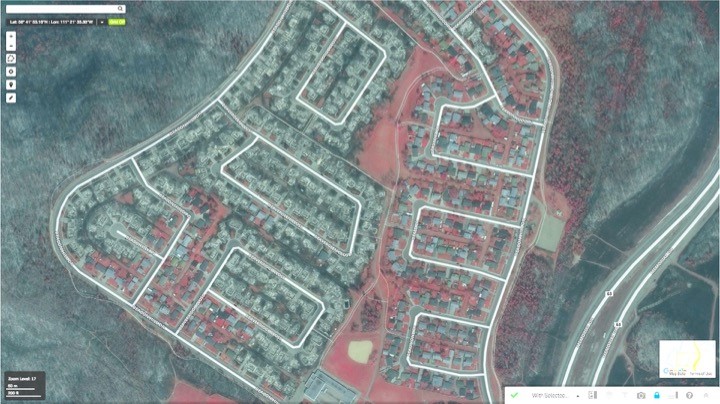 DigitalGlobe image collected Thursday, May 5, 2016[/caption]
[caption id="attachment_4579" align="alignnone" width="720"]
DigitalGlobe image collected Thursday, May 5, 2016[/caption]
[caption id="attachment_4579" align="alignnone" width="720"]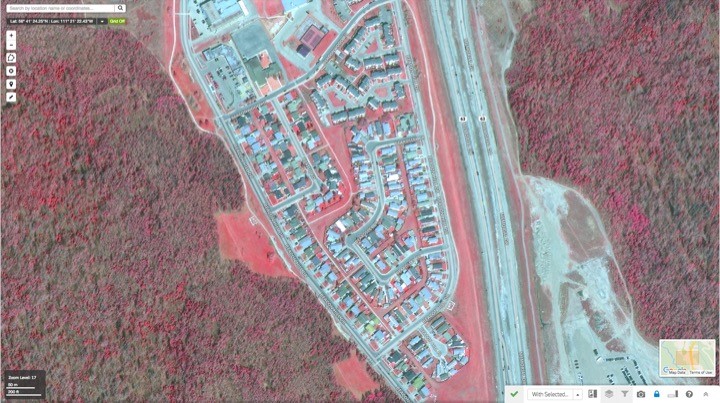 DigitalGlobe image collected Tuesday, May 3, 2016[/caption]
[caption id="attachment_4580" align="alignnone" width="720"]
DigitalGlobe image collected Tuesday, May 3, 2016[/caption]
[caption id="attachment_4580" align="alignnone" width="720"]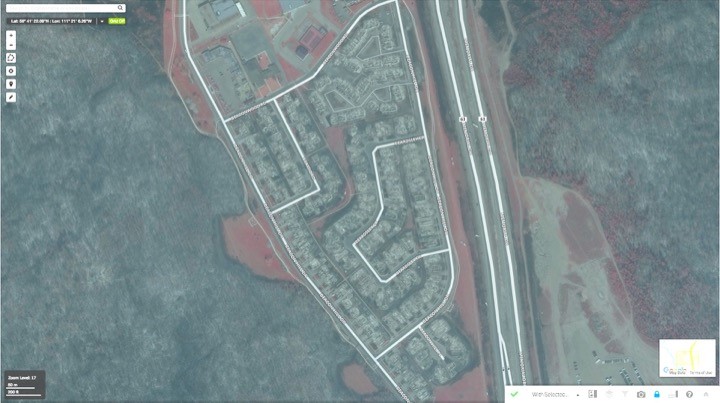 DigitalGlobe image collected Thursday, May 5, 2016[/caption]
DigitalGlobe image collected Thursday, May 5, 2016[/caption]
Hillview Park:
[caption id="attachment_4582" align="alignnone" width="720"] DigitalGlobe image collected Tuesday, May 3, 2016[/caption]
[caption id="attachment_4583" align="alignnone" width="720"]
DigitalGlobe image collected Tuesday, May 3, 2016[/caption]
[caption id="attachment_4583" align="alignnone" width="720"] DigitalGlobe image collected Thursday, May 5, 2016[/caption]
DigitalGlobe image collected Thursday, May 5, 2016[/caption]
Waterways:
[caption id="attachment_4584" align="alignnone" width="720"] DigitalGlobe image collected Tuesday, May 3, 2016[/caption]
[caption id="attachment_4585" align="alignnone" width="720"]
DigitalGlobe image collected Tuesday, May 3, 2016[/caption]
[caption id="attachment_4585" align="alignnone" width="720"]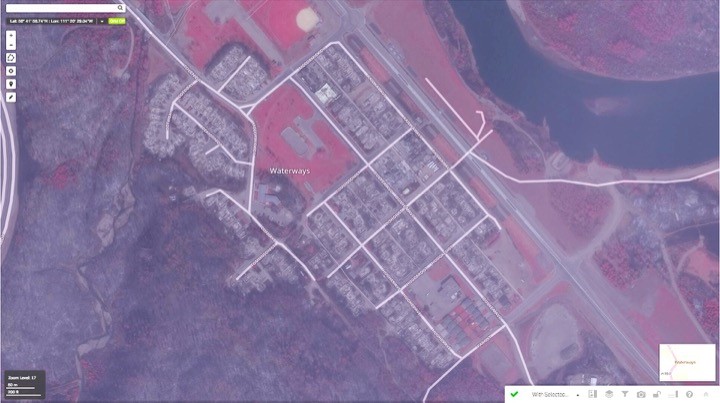 DigitalGlobe image collected Thursday, May 5, 2016[/caption]
If this story isn’t scary enough, check out the fire danger map from Natural Resources Canada, much of the Canadian Great Plains are in extreme or very high fire risk. This is shaping up to be a long, dangerous fire season. We will be monitoring the situation every day from space and collecting more imagery like the above as needed. Our thoughts are with all those impacted by these fires and hope everyone in Western Canada is safe.
[caption id="attachment_4586" align="alignnone" width="700"]
DigitalGlobe image collected Thursday, May 5, 2016[/caption]
If this story isn’t scary enough, check out the fire danger map from Natural Resources Canada, much of the Canadian Great Plains are in extreme or very high fire risk. This is shaping up to be a long, dangerous fire season. We will be monitoring the situation every day from space and collecting more imagery like the above as needed. Our thoughts are with all those impacted by these fires and hope everyone in Western Canada is safe.
[caption id="attachment_4586" align="alignnone" width="700"] Courtesy Natural Resources Canada[/caption]
Courtesy Natural Resources Canada[/caption]